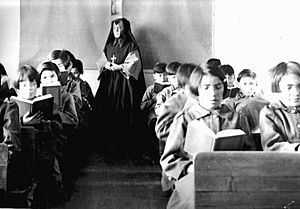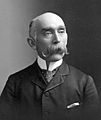Canadian Indian residential school system facts for kids
Until 1996, many Indigenous children in Canada were forced to attend special boarding schools. These schools were meant to make them forget their own cultures and become more like white Canadian society. This system of schools for First Nations children was called the Indian residential school system.
Christian churches ran these schools, and the Canadian government gave them money. These schools operated for over 100 years, and more than 150,000 children went to them. Sadly, at least 3,200 of these children died while at the schools.
Many residential schools started after the Indian Act was passed in 1876. In 1896, a change to the Act made it mandatory for all First Nations children to go to school. Many Indigenous communities were far from regular schools, so children had to go to residential schools and live there for the school year. These schools were often very far from their families. This was done to encourage them to adopt new ways of life. There were residential schools in every Canadian province and territory, except for New Brunswick and Prince Edward Island.
At these schools, children were forced to give up their cultures. They were given new names and were not allowed to speak their mother tongues. They could not visit their families. Children were often treated badly and abused at these schools. When students finished school, they often felt like they didn't fit in with their Indigenous communities or with mainstream Canadian society. They didn't learn traditional skills needed to live off the land. At the same time, the schools didn't teach them how to live in cities or protect them from racism.
In 2008, Prime Minister Stephen Harper apologized to the survivors of the residential schools on behalf of the Canadian government. The government also created the Truth and Reconciliation Commission (TRC). Its job was to find out the full truth about what happened at these schools. Many survivors came forward and shared their painful experiences. In 2015, the TRC released a report that said the residential school system was a form of cultural genocide.
Contents
How Did Residential Schools Start?
Since Europeans first arrived in North America, they tried to teach the native peoples about European ways. Europeans believed in something called the discovery doctrine. This idea suggested it was acceptable to colonize land because the people living there were not Christian and were seen as "uncivilized." They thought it was their duty to teach others about Christianity and "civilization."
French missionaries started some schools for Indigenous people in the 1600s. However, they stopped because making Indigenous people unhappy was bad for the fur trade.
In the 1820s, English missionaries opened schools in what is now Manitoba and Ontario. Unlike the French schools, these taught Protestantism.
The Canadian government became interested in starting schools for Indigenous people. This was because Indigenous people were no longer allies in wars. Instead, they were seen as a problem because many were nomads and didn't practice agriculture. The Department of Indian Affairs (DIA) worked with churches to send more Indigenous children to residential schools. Their goal was to "kill the Indian in the child" by converting them to Christianity and making them part of European-Canadian society. The government provided the buildings and money, while the churches provided the teachers and staff.
Most of the schools run by churches were managed by the Catholic Church. Other schools were run by the Anglican Church, the United Church of Canada, and the Presbyterian Church.
What Was Life Like in Residential Schools?
Students at the schools were often treated poorly by teachers and staff. Some teachers believed that hitting students would help save their souls and stop them from running away. It was considered bad for a school if students ran away, especially if a student died while trying to escape. Students were often malnourished. The schools were crowded, dirty, cold, and did not have good medical care. This meant that many students got sick with diseases like tuberculosis.
How Were Students Taught?
In residential schools, students learned in the same way European children were taught. This was very different from how First Nations people traditionally taught their children. Indigenous people used a "look, listen, learn" method of education. This did not involve classrooms or books. Instead, they taught their kids through games, stories, and ceremonies. Children struggled with book-learning because it was not how their parents had taught them. They were also forced to speak English and French. Sometimes, they were beaten if they spoke their native languages.
Did Students Resist?
The residential schools did not fully succeed in erasing Indigenous cultures. In some cases, students even burned down the schools as a form of resistance.
Why Did So Many Students Die?
Many students died at the schools, mostly from diseases. The poor living conditions and lack of medical care contributed to this.
When Did the Schools Close?
Many Indigenous communities began to take over the schools. They felt that the schools were not doing a good job of teaching their children.
Some residential schools became regular day schools. Other schools were burned down or torn down by former students. And some buildings are now abandoned.
What Were the Effects of the Schools?
Residential school survivors lost a lot of their culture. They often felt powerless. To cope with their feelings, some hurt themselves or others around them.
Many survivors still have mental health problems today because of their experiences at the schools.
Who Apologized for the Schools?
In 1986, the United Church of Canada said sorry for its role in colonization. In 1996, it apologized specifically for running residential schools.
In 1993, the Anglican Church apologized. The next year, the Presbyterian Church also apologized.
In 2004, the Royal Canadian Mounted Police (RCMP) apologized for forcing children into the schools.
The Canadian Government's Apology
In 2009, Prime Minister Stephen Harper apologized to the survivors of the residential schools. His apology was shown on television across the country.
The Vatican and Pope Francis's Apology
In 2009, the Vatican released a statement that expressed sorrow for the Church's involvement in harming Indigenous Canadians.
In 2017, Prime Minister Justin Trudeau asked Pope Francis for a full apology to the survivors, not just an expression of sorrow.
During a visit to Canada in July 2022, Pope Francis apologized for the Church's role in the Canadian Indian residential school system.
Images for kids
-
Fur traders, in what is now Canada, trading with an Indigenous person in 1777
-
Residential school group photograph, Regina, Saskatchewan, 1908
-
Governor General Mary Simon, who is Inuk, is the first Indigenous person to be appointed to the viceregal post
-
Former St. Michael's Residential School in Alert Bay, British Columbia. Formerly standing on the traditional territory of the ‘Namgis First Nation, it was demolished in February 2015.
See also
 In Spanish: Escuelas residenciales indígenas de Canadá para niños
In Spanish: Escuelas residenciales indígenas de Canadá para niños






















